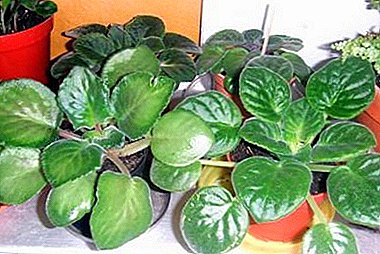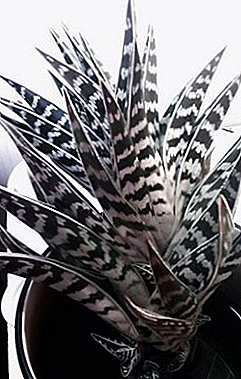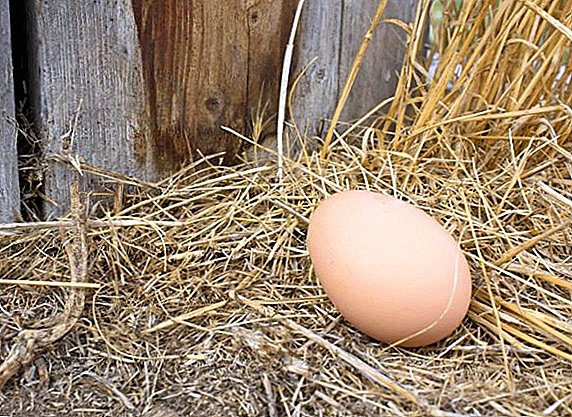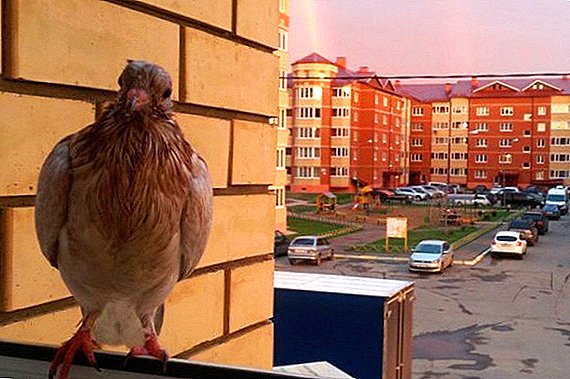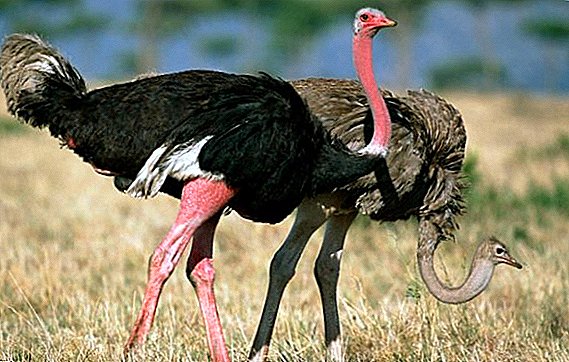 Since ancient times, ostriches have attracted the attention of people both as an object of hunting and as a subject of scientific interest. After the extermination of people by giant birds, the bushes became the largest birds on Earth. In this article we will talk about the habits and lifestyle of this interesting animal.
Since ancient times, ostriches have attracted the attention of people both as an object of hunting and as a subject of scientific interest. After the extermination of people by giant birds, the bushes became the largest birds on Earth. In this article we will talk about the habits and lifestyle of this interesting animal.
What does an ostrich look like?
Currently, there is a single species of ostrich family and genus of ostriches, namely African Ostrich (Struthio camelus). It has several subspecies: ordinary, or North African, Masai, Somali and southern. The Somali subspecies, outwardly very similar to the rest of the fellows, some researchers distinguish in a separate species.  Let us dwell on the signs of the common (North African) ostrich:
Let us dwell on the signs of the common (North African) ostrich:
- solid body, large;
- the keel (bone growth of the sternum to which the pectoral muscles are attached to birds) is absent;
- the neck is long, devoid of feathers, painted red;
- head small, slightly flattened from above;
- large eyes, upper eyelid pubescent with thick eyelashes;
- beak straight, flat, has a growth;
- wings are underdeveloped, used for balancing the body and for mating;
- hind limbs lack feathers, very long, powerful, have only 2 fingers, equipped with claws, the length of a large claw reaches 7 cm;
- coloring of the plumage of the female is nondescript; grayish-brown shades prevail, wings and tail are of a dirty-white color;
- the torso of the males is covered with black feathers, the wings (in part) and the tail are dazzling-white;
- the height of the bird reaches 270 cm, and the weight can exceed 150 kg (the females are a bit smaller than the males);
- can run at speeds of up to 80 km / h at short distances, taking steps of 3.5–4.5 m, while they can maintain speeds of about 50 km / h for a long time.


Important! A large flightless bird lives in Australia, which was relatively recently called the emu ostrich and belonged to the ostrich family. But in the 80s of the last century, the classification was revised, and the emu was ranked as a separate family of the emu (Dromaiidae) and the genus of the emu.
Why don't they fly and hide their heads in the sand
Scientists believe that the ancestors of ostriches once could fly, but eventually lost this ability. As a result of evolution, their keel disappeared from the sternum, to which the muscles that move the wings are attached to the flying bird. Fly and tail feathers remained, but turned into decorative elements. The wings themselves are used for balancing in the process of running, for protection, and are also shown to the females in the opened state during the mating games.  As for the legend of ostriches, allegedly hiding their heads in the sand with danger, its sources are attributed to the message of the ancient Roman historian Pliny the Elder. In reality, this bird can only pick up pebbles from the sand, which it needs for normal digestion, and it often escapes from danger by running away, since it is capable of developing a very high speed.
As for the legend of ostriches, allegedly hiding their heads in the sand with danger, its sources are attributed to the message of the ancient Roman historian Pliny the Elder. In reality, this bird can only pick up pebbles from the sand, which it needs for normal digestion, and it often escapes from danger by running away, since it is capable of developing a very high speed.
Did you know? The diameter of ostrich eyes is approximately 50 mm. One eye, both in mass and in size, exceeds the size and mass of the brain of this bird, as well as the size of an elephant's eye.
How the ostrich is protected from enemies
The main method of protection of ostriches - fast-paced flight, and they can dramatically change the direction of the race, without reducing speed. However, they are able to come together with the enemy in direct combat. In this case, the bird strikes hard with its paws, the fingers of which are equipped with powerful claws. It strikes forward and down, and in addition, it can flap its wings. With a paw blow, she can seriously injure even a lion.  In addition to the above methods of protection, the bird uses a disguise. The female incubating the eggs, when the danger is noticed, literally spreads out on the ground, bending over the long neck, and its gray-brown color contributes to stealth.
In addition to the above methods of protection, the bird uses a disguise. The female incubating the eggs, when the danger is noticed, literally spreads out on the ground, bending over the long neck, and its gray-brown color contributes to stealth.
Where live and how much live
The North African subspecies inhabits vast areas, from Ethiopia and Kenya in eastern Africa to West African Senegal. Its habitat is savannah and semi-desert. The life span of this bird is significant: in ideal conditions it can live 75 years, but in nature it usually lives no more than 40-50 years.
Read more about breeding ostriches at home.
Lifestyles and habits
This bird leads day life, but in the hottest daytime hours it is inactive. Ostriches are able to do without water for a long time, losing during its long absence up to a quarter of their body weight. If given the opportunity, they drink water in large quantities and bathe in water bodies, but more often they provide themselves with moisture by eating plants. Ostriches generally differ excellent adaptation to external conditions. In the desert, this bird quietly maintains a temperature of +55 ° C, and on ostrich farms in Europe, it feels good with a frost of -10 ... 12 ° C.  Before the mating season, ostriches gather in small and sometimes quite large flocks (up to hundreds of individuals). But sexually mature birds live in families, which usually include 1 adult male, up to 5 females and strausitas. Such a family very often grazes next to antelopes and zebras, and with them migrates to new pastures. At the same time, due to their keen eyesight and high growth, ostriches notice other predators stealing earlier than other animals.
Before the mating season, ostriches gather in small and sometimes quite large flocks (up to hundreds of individuals). But sexually mature birds live in families, which usually include 1 adult male, up to 5 females and strausitas. Such a family very often grazes next to antelopes and zebras, and with them migrates to new pastures. At the same time, due to their keen eyesight and high growth, ostriches notice other predators stealing earlier than other animals.
Important! The brain of this bird is very small compared to the large body, its mass reaches only 40 g. Scientists assume that ostriches are not able to remember anything. There were cases when the bird thrust its head into some hole and could not pull it out, because it did not remember how it did it. In such cases, it begins to twitch randomly and can literally rip the head from the cervical vertebra.
What feeds on
The basis of the ostrich's diet are the shoots of various plants, as well as their seeds and fruits. Its digestive system is optimized for the absorption of plant foods. This process is facilitated by small pebbles and sand swallowed by the bird, which, while in the stomach, contribute to the grinding of plant fibers.
However, the bird is not limited to plants. If possible, it eats lizards, turtles, insects (the locust is especially loved by it) and small rodents, and it can consume the remains of animals that have not been eaten by predators.
Learn more about eating ostriches in the wild and at home.
Breeding
Under natural conditions, the female becomes mature at 3 years of age, and the male at 4 years of age. In the mating season, the male makes sounds that attract the female - hissing, trumpet screams, etc. In addition, he flaps his wings in front of the female, crouches, throws back his head. The territory in which the male conducts mating games can reach 15 square meters. km Other males are banished from this territory. In the resulting harem, the male covers all the females, but he is approached by one dominant individual.  Under the nest, the male digs a hole in the ground with his claws. All females of the harem lay eggs in this pit (the weight of one is up to 2 kg). When the dominant individual has made its laying, it drives away other females from the nest and arranges its own eggs in the center of the common laying.
Under the nest, the male digs a hole in the ground with his claws. All females of the harem lay eggs in this pit (the weight of one is up to 2 kg). When the dominant individual has made its laying, it drives away other females from the nest and arranges its own eggs in the center of the common laying.  The clutch size is on average 20 eggs (for other subspecies it can be much larger). During the day the dominant female incubates the clutch; at night, the male. The process of incubation lasts 35-45 days. During this period, the females and males are very aggressive: defending the clutch, they can attack any animal or man.
The clutch size is on average 20 eggs (for other subspecies it can be much larger). During the day the dominant female incubates the clutch; at night, the male. The process of incubation lasts 35-45 days. During this period, the females and males are very aggressive: defending the clutch, they can attack any animal or man.  The process of hatching chicks can last more than 1 hour. They break through the thick shells with their beak and head. Hatching strausits weigh more than 1 kg, they are covered with bristles, their eyesight functions normally and they can move freely.
The process of hatching chicks can last more than 1 hour. They break through the thick shells with their beak and head. Hatching strausits weigh more than 1 kg, they are covered with bristles, their eyesight functions normally and they can move freely.  It is noteworthy that the eggs from which the chicks have not hatched, are broken by the female. Insects flying on them serve as additional food for the chicks. But even without this, the ostrich bug is able to travel with adults in search of food the next day after its birth.
It is noteworthy that the eggs from which the chicks have not hatched, are broken by the female. Insects flying on them serve as additional food for the chicks. But even without this, the ostrich bug is able to travel with adults in search of food the next day after its birth.
Learn how to incubate ostrich eggs at home and how to make an incubator for ostrich eggs with your own hands.
At the 3rd month of life, the ostrich cat begins to cover with feathers. One year old youngsters are already quite ready for independent living, but, as a rule, they remain in the family for some time.  It is curious that the strausits bind to each other, groups of strausts from different families can unite into one, then males fight for guardianship over the united group, and the winner takes the young with them.
It is curious that the strausits bind to each other, groups of strausts from different families can unite into one, then males fight for guardianship over the united group, and the winner takes the young with them.
Did you know? In farms, ostriches are bred for meat, fat, eggs, skin, and feathers. Meat tastes similar to lean beef. Fat is used in pharmacology and cosmetology. The calorie content of eggs is slightly lower than that of chicken, but the taste is the same. The skin is distinguished by its strength, elasticity, water resistance and durability. Feathers are used for finishing clothes, as well as decorative elements.
Population and conservation status
In the XIX century, the extermination of ostriches, mainly for the sake of their feathers, assumed such proportions that this bird was threatened with real extinction in the near future. One of the subspecies, the Syrian ostrich, subsequently practically disappeared and became completely extinct already in the middle of the 20th century.
Fortunately, in the middle of the XIX century, these birds began to be bred on ostrich farms, and now there is no threat to the existence of this species.
Video: ostrich ordinary
As you can see, the ostrich is a rather unusual creature: it is a non-flying and the world's largest bird, preferring to run away from danger, but if necessary entering into a fight with any predator. Its interesting feature is also the formation of a stable family and long-term care for the offspring. Experiments on its domestication turned out successful, as a result of which the threat of depopulation of this bird disappeared, and ostrich breeding became an important area of poultry farming.


